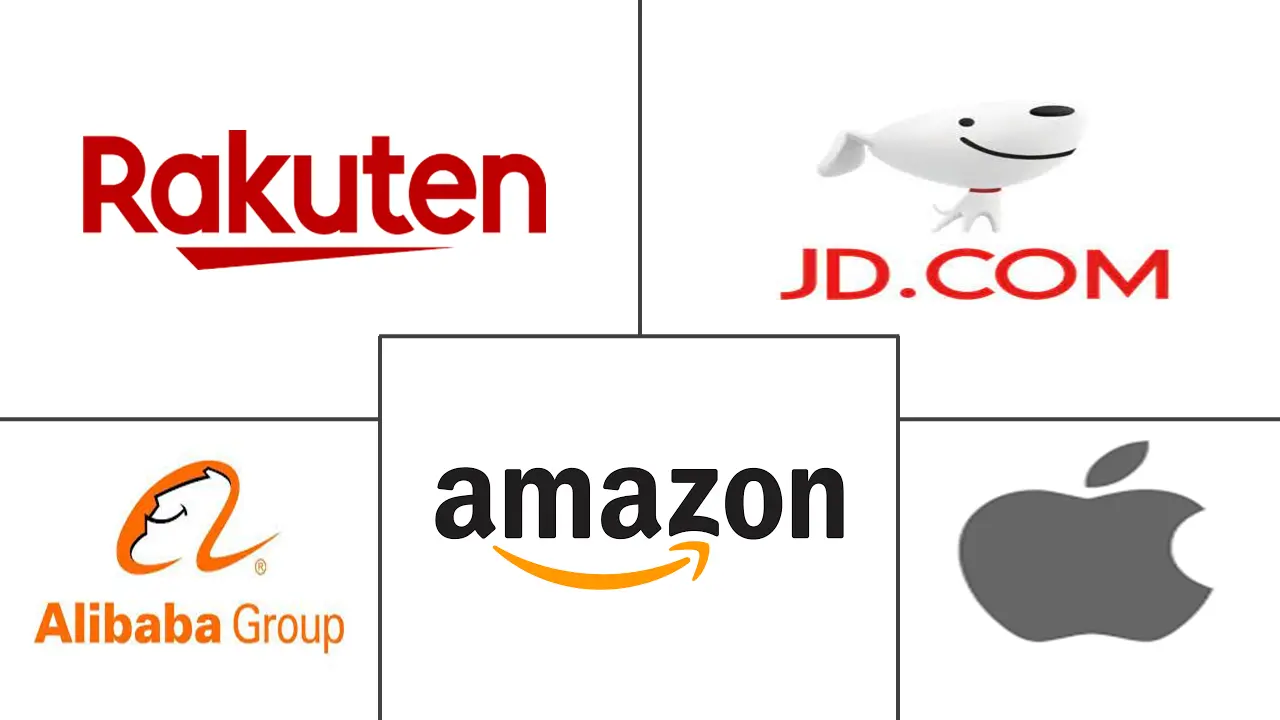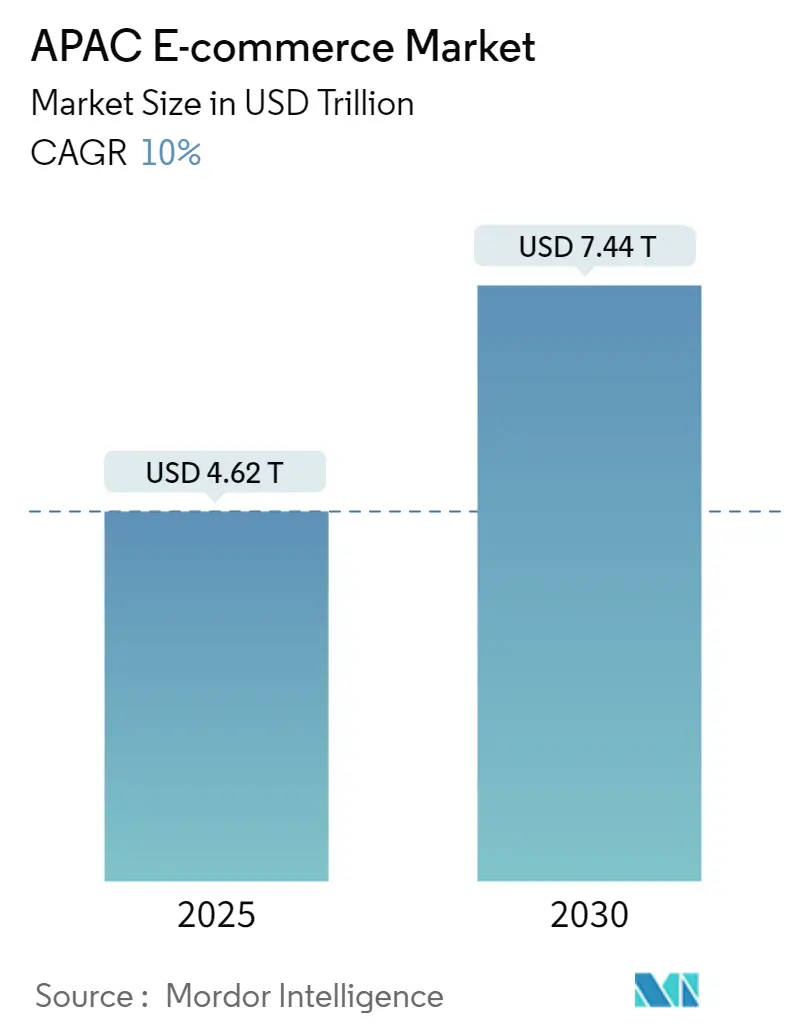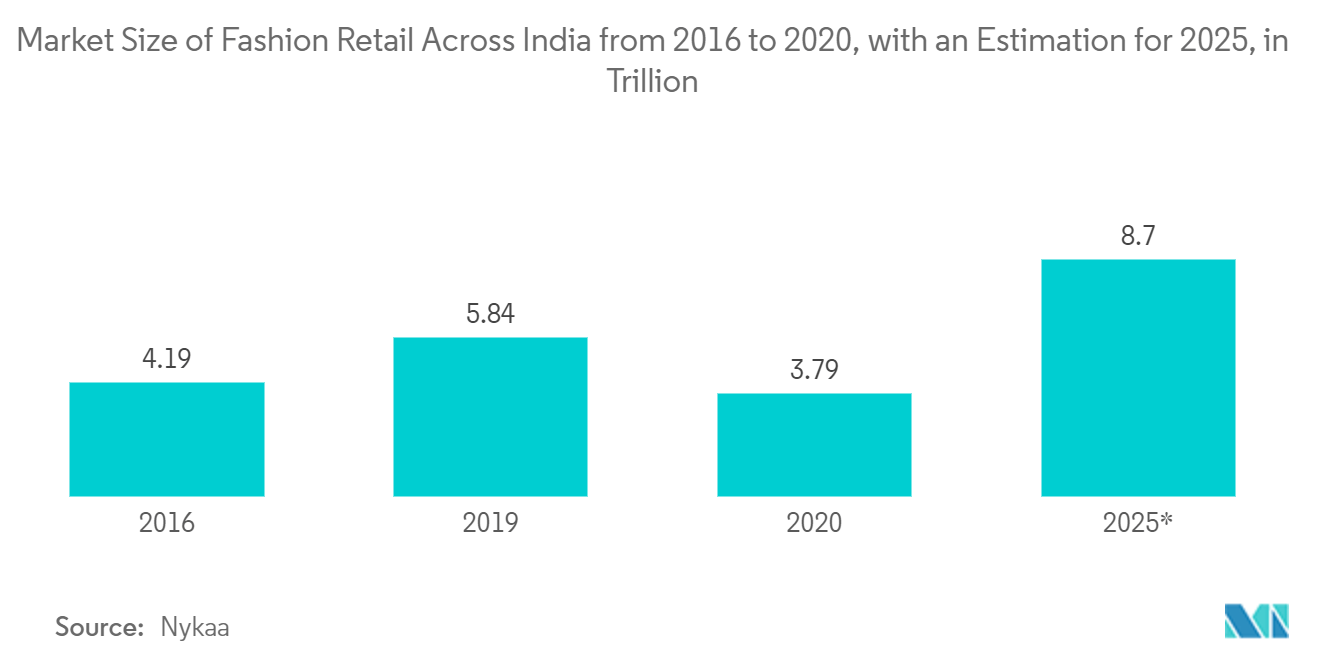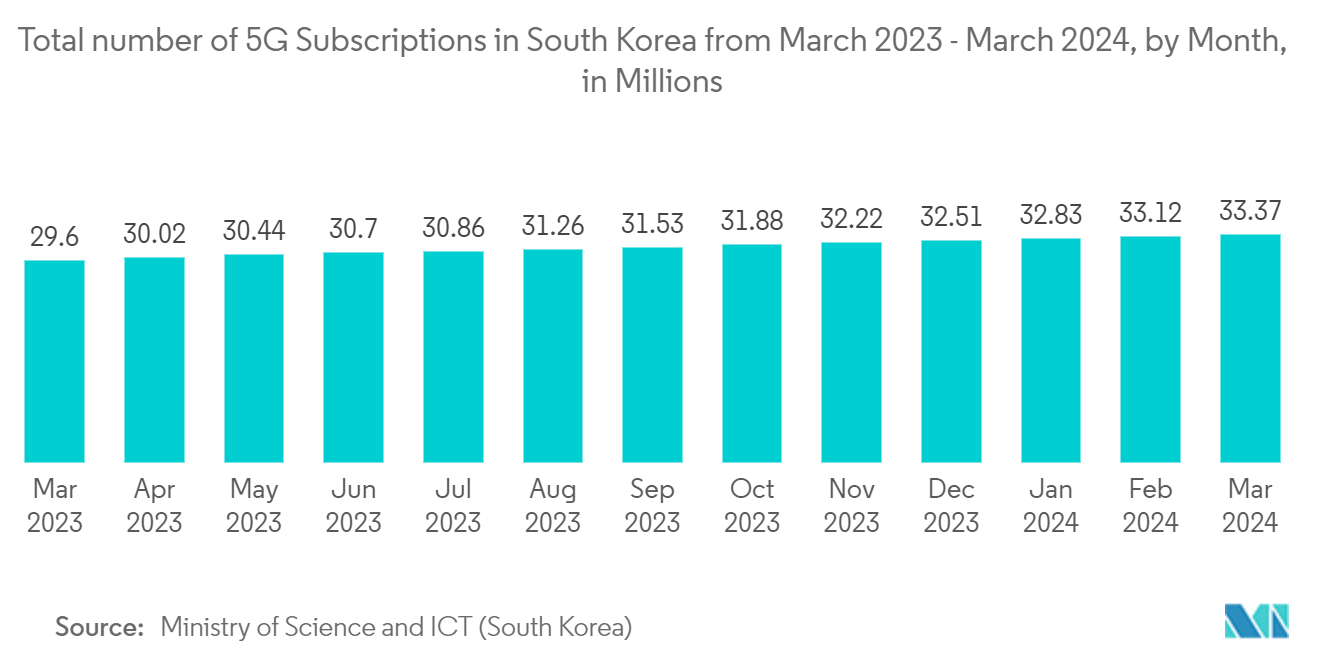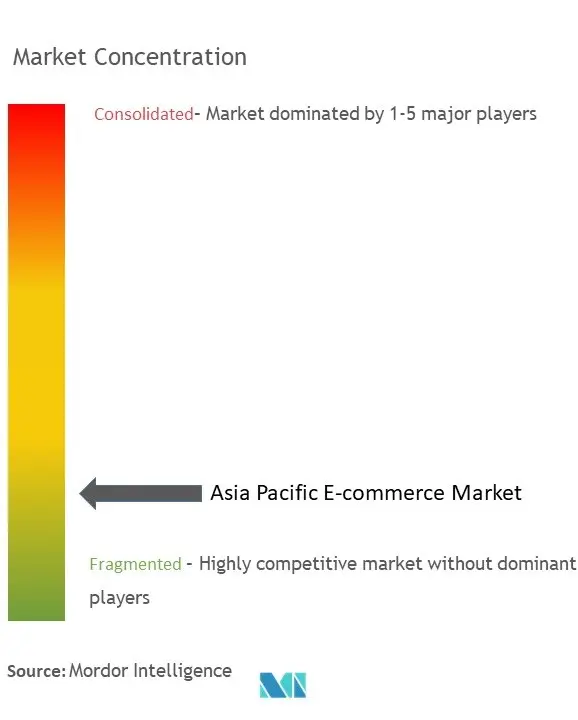APAC E-commerce Market Analysis
The APAC E-commerce Market size is estimated at USD 4.62 trillion in 2025, and is expected to reach USD 7.44 trillion by 2030, at a CAGR of 10% during the forecast period (2025-2030).
Consumers around the region have started to focus on online shopping due to expanding internet access and the quick, efficient, and effective distribution of goods.
- Asia has experienced a rapid increase in internet accessibility and penetration, which has sparked the region's subsequent digitization. Other industries transformed to keep up with the new, technology-driven economy worldwide, along with the area and its residents. The retail sector is one such enterprise.
- Ready-to-eat food delivery has become a significant market due to enticing, user-friendly apps, tech-enabled driver networks, and shifting consumer expectations. Food delivery services now provide a convenient and efficient way to buy food whenever and wherever customers want. The invention of online food delivery services came about due to new technological advancements and the COVID-19 outbreak, which compelled food service operators to develop innovative methods and platforms to minimize customer interaction when ordering and eating meals.
- One of the biggest trends in online retail is platform convergence. Customers prefer an all-in-one shopping experience that includes product ratings and prices, buying, and making payments using the platforms' new online payment options. Consequently, online shopping features are available on portal websites, social media, TV home shopping, over-the-top media services (OTT), etc. As a result, their platforms are becoming more popular.
- E-commerce enterprises generally store customers' bank accounts and credit card information. Email addresses, mailing addresses, usernames, and passwords are usually held by e-commerce enterprises, subjecting them to cybersecurity attacks. Cybercriminals profit from this information by duplicating credit cards and utilizing users' personal information for identity theft and fraud. Hackers may potentially hold sensitive data hostage for ransom.
APAC E-commerce Market Trends
Fashion and Apparel to Witness the Growth
- Asia Pacific is now regarded as one of the most significant emerging fashion markets and is becoming increasingly famous. Saturation in the West has caused many businesses to change their emphasis and seek out emerging markets, which is expected to develop the fashion and apparel industries in the region.
- Moreover, India has an economically expanding fashion industry, with several local names accounting for a sizable portion of total fashion sales. Aside from that, the country has a powerful impact on street style, particularly among the younger groups. Furthermore, India has its own set of patterns and retail and online players. Although there is a strong preference for Western luxury goods, customers in the nation have individual preferences for them.
- Local celebrities and pop culture icons also greatly influence the populace. Moreover, many Western companies use these personalities as brand ambassadors. Their distinct style can influence public opinion and set significant national developments. These trends could attract large players to invest in fashion e-commerce activities to enhance their offerings across the country.
- Consumer demands in the fashion market are becoming increasingly complicated and varied due to increased consumption and rising disposable incomes. Other factors include the growing desire for individuality and personalized fashion, the growth of life-enriching consumption such as leisure and cultural activities, an increase in internet sales, an aging population, and a change in core consumers. Such trends would significantly increase e-commerce sales in the fashion industry.
South Korea to Witness the Growth
- To create their current and future omnichannel operations, e-commerce businesses have realized the value and necessity of mobile commerce (m-commerce) with efficient, user-friendly apps. During the forecast period, the introduction of 5G is expected to be one of the primary factors driving mobile traffic growth from B2C websites in South Korea. Despite the publicity in South Korea about the potential of 5G radiation being harmful to human health and the high cost of installing 5G in mobile telecommunications operators' infrastructure, the higher bandwidth and much faster connection speed that 5G represents can be expected to boost the development of mobile traffic.
- The rapid development of wireless and internet technology has significantly impacted online retailing and e-commerce advancement. The accessibility of smart devices, advances in telecommunications infrastructure, rising purchasing power, a lack of time, and additional convenience have compelled businesses to adopt technology and meet customers' expanding needs, which has sped up the development of this new business model for online food ordering.
- E-commerce is driving the rise of the Korean retail industry. The industry is expanding quickly, but traditional retail outlets are struggling. Customers typically browse standard retailer merchandise while browsing online for the most incredible prices.
- Furthermore, the primary marketing outlets for both domestic and foreign cosmetic goods are online shopping malls and specialized offline shops. In Korea, e-commerce platforms, such as online stores, are gaining popularity.
APAC E-commerce Industry Overview
The level of rivalry in the industry is high, owing to the large number of players operating in the market, and the growing popularity and adoption of e-commerce are attracting newer players to the market, thus increasing the competitive rivalry in the Asia-Pacific e-commerce market.
In May 2023, JD.com, Inc. announced "One-Stop Shopping for Home Products and Appliances." It includes consistently putting customers first and upgrading services; retail-driven, healthy, and sustainable development; upgrading product offerings; making structural breakthroughs; developing omnichannel and establishing an industry ecosystem; enhancing cost and efficiency; and achieving win-win outcomes with partners.
In April 2023, Amazon established the Anti-Counterfeiting Exchange (ACX), an industry partnership to improve online shopping security and make it more challenging for counterfeiters to move between different sites to sell their fake goods. Participating retailers can exchange data with ACX regarding proven counterfeiters who have tried to use their services to try to sell fake goods. Participants in the ACX can detect and end offenders more rapidly than they could without this cooperative data sharing by exchanging information about these counterfeiters. An impartial third party offers participants anonymous access to share and receive information in compliance with industry standards and best practices.
APAC E-commerce Market Leaders
-
Amazon.com Inc.
-
Alibaba Group Holding Limited
-
Rakuten Group, Inc.
-
Apple Inc.
-
JD.com, Inc.
- *Disclaimer: Major Players sorted in no particular order
APAC E-commerce Market News
- April 2023: TMON announced that the company would open a 'Sports & Leisure Special Hall" and introduce popular sports and outdoor items at exceptional prices. An additional 8% discount was also available when paying with Kakao Pay. This is expected to help athletic people stretch in warm spring weather.
- February 2023: JD.com, Inc. announced this week that it launched "ChatJD," an industrial version of ChatGPT focused on the vertical industrial fields of retail and finance. The industrial ChatJD will likely roll out through one platform, two areas, and five applications. It is expected to build a human-computer dialogue platform that understands and generates tasks in natural language processing, with parameters estimated to total hundreds of billions.
APAC E-commerce Industry Segmentation
E-commerce refers to selling clothing, electronics, furniture, books, cosmetics, and other items over the Internet. Companies that provide home delivery services, such as e-commerce and m-commerce, are included in this industry.
The Asia-Pacific e-commerce market is segmented by application (beauty and personal care, consumer electronics, fashion and apparel, food and beverage, furniture, and home), by country (China, India, Japan, South Korea, and the rest of Asia-Pacific). The report offers market forecasts and size in value (USD) for all the above segments.
| By B2C ecommerce | Market size (GMV) for the period of 2017-2027 | ||
| Market Segmentation - by Application | Beauty & Personal Care | ||
| Consumer Electronics | |||
| Fashion & Apparel | |||
| Food & Beverage | |||
| Furniture & Home | |||
| Other Applications (Toys, DIY, Media, etc.) | |||
| By B2B ecommerce | Market size for the period of 2017-2027 | ||
| Geography*** | China | ||
| India | |||
| Japan | |||
| South Korea | |||
APAC E-commerce Market Research FAQs
How big is the APAC E-commerce Market?
The APAC E-commerce Market size is expected to reach USD 4.62 trillion in 2025 and grow at a CAGR of 10% to reach USD 7.44 trillion by 2030.
What is the current APAC E-commerce Market size?
In 2025, the APAC E-commerce Market size is expected to reach USD 4.62 trillion.
Who are the key players in APAC E-commerce Market?
Amazon.com Inc., Alibaba Group Holding Limited, Rakuten Group, Inc., Apple Inc. and JD.com, Inc. are the major companies operating in the APAC E-commerce Market.
What years does this APAC E-commerce Market cover, and what was the market size in 2024?
In 2024, the APAC E-commerce Market size was estimated at USD 4.16 trillion. The report covers the APAC E-commerce Market historical market size for years: 2019, 2020, 2021, 2022, 2023 and 2024. The report also forecasts the APAC E-commerce Market size for years: 2025, 2026, 2027, 2028, 2029 and 2030.
Our Best Selling Reports
APAC E-commerce Industry Report
The e-commerce industry in Asia-Pacific is witnessing a remarkable surge, driven by digital adoption and the widespread use of internet and mobile devices. This transformation is reshaping consumer behavior towards online shopping and spans various transactions, including B2C, B2B, C2B, and C2C, across platforms like open-source, SaaS, and headless commerce. This shift is contributing significantly to the industry growth, making the e-commerce industry size in Asia more substantial than ever.
The market's diversity in product types, services, and platforms indicates a dynamic ecosystem expected to drive innovation and growth. This expansion is further supported by an array of payment solutions and the rise of mobile commerce, offering vast opportunities for businesses and governments alike. According to Mordor Intelligence™ Industry Reports, the APAC e-commerce market share, size, and revenue growth rate are on an upward trajectory, with forecasts and historical overviews suggesting a promising future.
The report covers APAC e-commerce consumer market trends and is segmented by B2C e-commerce, including beauty and personal care, consumer electronics, fashion and apparel, food and beverage, furniture and home, as well as B2B e-commerce. The analysis report underscores the region's pivotal role in the global market, contributing substantially to the overall e-commerce industry size in Asia.
For those seeking detailed insights, a free report PDF download is available, offering a comprehensive market forecast outlook. This report provides valuable industry statistics, industry trends, and market segmentation, which are crucial for understanding the industry outlook. The market analysis reveals significant market growth, driven by the industry's robust market value and market data.
The industry analysis highlights the importance of industry research and industry reports in understanding the market dynamics. The report covers various aspects such as market forecast, market overview, and market outlook, which are essential for businesses aiming to capture market share. The industry information provided in the report is vital for market leaders and research companies to make informed decisions.
In summary, the Asia-Pacific e-commerce market is set for significant growth, with industry size and industry statistics pointing towards a bright future. The market's growth rate and market trends indicate a thriving sector, poised for continued expansion. This comprehensive report serves as an indispensable resource for anyone looking to understand the market structure, market segments, and market predictions in the APAC region.

